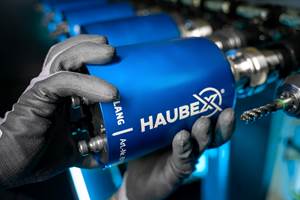Cobots and Beyond
Collaborative robots address a challenge that will continue to be addressed.
Share




Common as robots are in futuristic stories, I know of no story dealing with the challenges real-life robots present. One of these is the challenge of keeping industrial robots from injuring us, either because of their unthinking motions or ours.
In recent years, the commercialization of collaborative robots has made this challenge a topic of interest. Traditionally, the safe use of robots in manufacturing has relied on barriers that keep people and robots separated. Yet that approach is inefficient, consuming floor space for the caged-in area and limiting the work that people and robots can do together. The “cobots” offer a different solution. These robots move without enough speed or force to do harm, and they are force-sensing, stopping in response to any obstruction that might be a person. Are these cobots the way forward for industrial automation?
They are part of the way forward, says John Burg, founder of robotics integrator Acieta. I recently spoke with him at an event focused on collaborative robots at his company’s Iowa headquarters.
An example of an application he has seen in which a cobot makes sense is this: A basket sent into heat treatment gets manually loaded with parts. Various different baskets have warped differently after many heat-treat cycles, so automated loading of the baskets is problematic. However, a robot lifts each basket of parts once it is full. Here, collaborative technology makes it safe and simple for a person and a robot to complete the task together.
But in a different application in which the user was initially focused on a collaborative robot, in this case for part loading, Mr. Burg says the user’s productivity called for a narrow cycle time target for the robot. As it happened, the cobot’s limited speed proved too slow to meet that need.
This points to a challenge with the new technology, he says. Because it is new, and because it offers some manufacturers a promising new way to use robots, many are rushing to cobots in applications where they arguably don’t make sense.
Another speaker at the Acieta event was Claude Dinsmoor, general manager for material handling robotics with FANUC America. His company’s cobots were running in part-loading demonstrations at this event. (I let one hit me to see its responsive stopping.) He, too, says collaborative robots are an important development, but not the final answer to the safety challenge. Indeed, he tells a futuristic story of his own.
One solution already in use today, he notes, is the “fenceless” robot. Sensors used in conjunction with a robot at full speed and power can enable it to slow if a person comes near and stop if a person comes very close. How much further could this idea go?
Maybe the day will come when something like a collaborative robot is not collaborative all the time, but instead has limitations that reliably activate when people are in proximity. In the future, he says, perhaps it will be advances in the sensitivity, specificity and responsiveness of sensors that will allow fast, forceful robots to unguardedly operate within the same production space where people also work.
Related Content
Cutting Part Programming Times Through AI
CAM Assist cuts repetition from part programming — early users say it cuts tribal knowledge and could be a useful tool for training new programmers.
Read More4 Steps to a Cobot Culture: How Thyssenkrupp Bilstein Has Answered Staffing Shortages With Economical Automation
Safe, economical automation using collaborative robots can transform a manufacturing facility and overcome staffing shortfalls, but it takes additional investment and a systemized approach to automation in order to realize this change.
Read MoreHow to Accelerate Robotic Deburring & Automated Material Removal
Pairing automation with air-driven motors that push cutting tool speeds up to 65,000 RPM with no duty cycle can dramatically improve throughput and improve finishing.
Read MoreUsing the Toolchanger to Automate Production
Taking advantage of a feature that’s already on the machine tool, Lang’s Haubex system uses the toolchanger to move and store parts, making it an easy-to-use and cost-effective automation solution.
Read MoreRead Next
Setting Up the Building Blocks for a Digital Factory
Woodward Inc. spent over a year developing an API to connect machines to its digital factory. Caron Engineering’s MiConnect has cut most of this process while also granting the shop greater access to machine information.
Read More5 Rules of Thumb for Buying CNC Machine Tools
Use these tips to carefully plan your machine tool purchases and to avoid regretting your decision later.
Read MoreBuilding Out a Foundation for Student Machinists
Autodesk and Haas have teamed up to produce an introductory course for students that covers the basics of CAD, CAM and CNC while providing them with a portfolio part.
Read More




















.jpg;maxWidth=300;quality=90)











